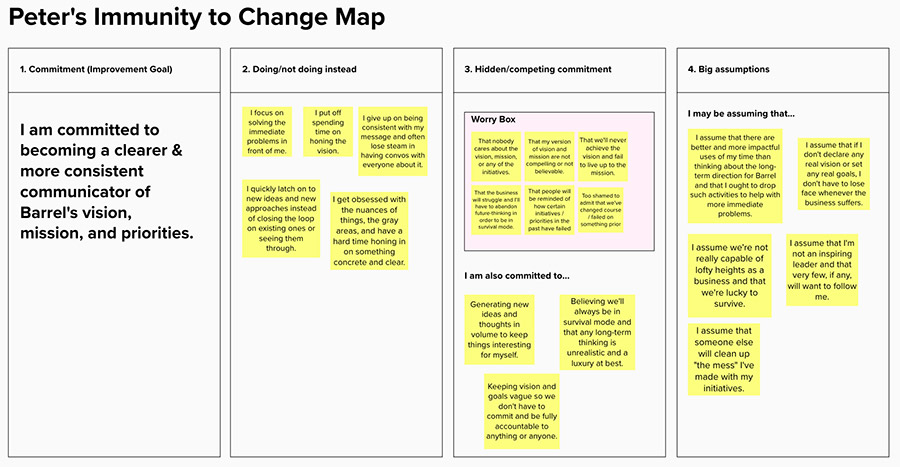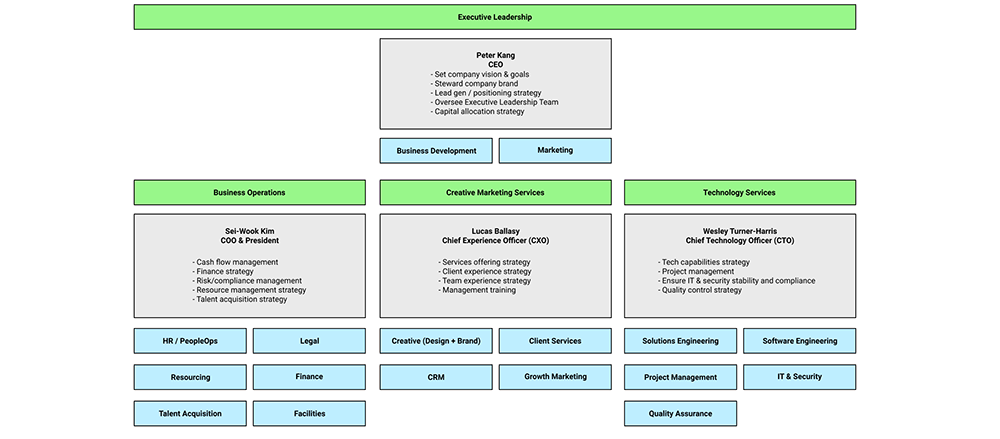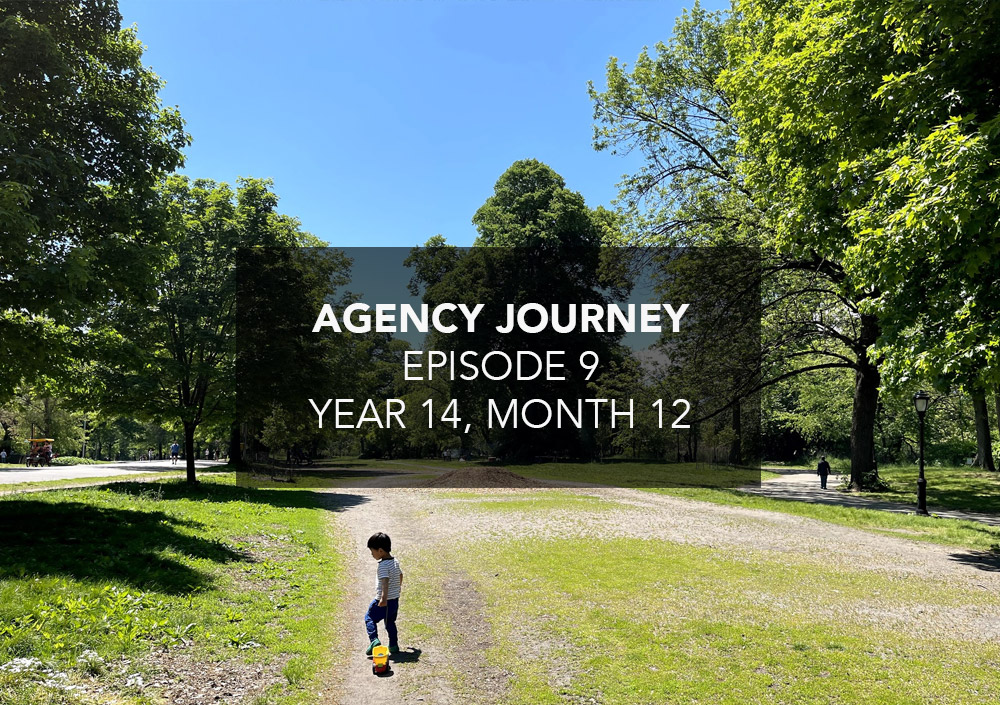There’s momentum and energy in the air at Barrel. And it’s not only because we launched new work for clients or won new business. It’s the result of committing to big goals, making hard decisions, and following through on proposed changes. It’s operating from a mindset of “why not?” and “why not us?” vs. one of fear and scarcity.
It’s taken me and Sei-Wook nearly 15 years to find our way to where we are today, to experience this mindset shift. It took a long time, maybe longer than it needed to. But rather than dwell on how slow we’ve been in learning and growing, I’m excited to look ahead and move fast towards our new future.
About Agency Journey: This is a monthly series detailing the happenings of my agency Barrel, founded in 2006. You can find previous episodes here.
Highlights
Launches & New Business Wins
At Barrel, the exciting feeling of a new client website launch never gets old. I thought I’d share a few of them here:

Screenshots of websites we launched for our clients recent, from left to right: The Asian American Foundation, Rowing Blazers, and Luck Springs
- The Asian American Foundation is a newly formed non-profit organization founded to serve the Asian American and Pacific Islander community. Its mission is to serve the Asian American and Pacific Islander community in pursuit of belonging and prosperity that is free from discrimination, slander and violence. TAAF made a big splash with the announcement that it had raised $250 million which would be used directly for AAPI causes, the largest such pledge ever. Barrel worked at a feverish pace with the TAAF team to get a website ready in 2 months. The organization launched to much fanfare with great press coverage and social amplification from dignitaries and celebrities.
- Rowing Blazers is a highly sought-after streetwear brand known for its youthful, self-aware, and ironic take on “preppy” fashion. We’ve been working closely with Rowing Blazers for the past year on various web, email, and paid marketing engagements. The biggest piece has been the redesign of their ecommerce website, which finally launched this month. Its spot-on collaborations with brands like the NBA, Warm & Wonderful (the Princess Diana sweaters), and Babar (the cartoon elephant) have driven tremendous growth.
- Luck Springs is a hard tea and lemonade brand from the folks behind our longtime client Austin Eastciders. It’s always fun to introduce a new beverage brand through a new website, and our team enjoyed the collaboration.
In addition to the launches, our team is continually helping our clients roll out new optimizations to their websites, launching new email marketing campaigns, and providing UX and design ideas. A lot of this work doesn’t get reflected in our portfolio but are an important part of the business and the value we bring to our clients.
Speaking of which, we’ve been on a roll with new business, booking a record amount of revenue in May including contracts to design and build an ecommerce website for an eyewear brand, a website development project for a womenswear fashion client, and a UX & design project for a well-known apparel brand. We’ve also stuck to our guns and kept to higher minimums for our fees, which has led to passing on a lot of deals. The disciplined decision-making, driven by our pricing minimums and business qualification matrix, has allowed us to focus our energies on larger opportunities with better margins and the opportunity to do higher quality work (more time & flexibility to staff the right resources).
Immunity to Change Map
In early May, the four Barrel partners met for our quarterly all-day session. We switched things up for this session and rather than following our usual structure of reviewing the previous quarter and setting priorities for the upcoming one, we focused most of the day on sharing each others’ Immunity to Change Map.
The concept of “Immunity to Change” comes from Harvard researchers and authors Robert Kegan and Lisa Lahey who discovered that people have ingrained habits backed by strong beliefs that are adept at resisting and fighting back any attempts at change, acting much like an immune system. The Immunity to Change Map is a tool that helps leaders articulate and commit to an improvement goal while surfacing the habits and beliefs that are fighting against the improvement goal.
We came across this while reading An Everyone Culture by Kegan and Lahey, a book about “deliberately developmental organizations” that have found unique ways to help its team members embrace growth mindsets and overcome their resistance to change. As a leadership team, we decided to take a chance to work on our respective Immunity to Change Maps and then share them with each other during our quarterly meeting.
To help identify our improvement goals, we asked our direct reports for feedback and also worked with our coaches to make sure that what we put down was significant and worthwhile.
The session the four of us had was quite powerful. It was perhaps the most vulnerable we’ve been in front of each other (tears may have flowed), and we were able to openly give each other both feedback and encouragement with complete honesty. What was striking was that at the most fundamental level, we all, to some degree, held fears and insecurities about failure–that others didn’t care for our ideas and contributions or that we might not be good enough.
I feel a bit sheepish going into the specifics of my Immunity to Change Map in public, but I’ll share a screenshot of my Map below for reference. I think it’s a worthwhile experience whether you do it alone or with a trusted group. I came away feeling a lot more confident and eager to face the decisions and challenges that I had previously shied away from or outright ignored.

My Immunity to Change Map that I shared with the Barrel partners during our quarterly meeting.
I feel incredibly fortunate to have had the space and the time to work on myself with this exercise. It’s easy to focus solely on the work and the immediate problems at hand. In fact, that’s what we did exclusively for the first 14+ years of Barrel. But as of late, I’ve realized more and more that so much of performance is about understanding how we function as humans–the psyche, the emotions, the physical health, the relationships, the values, and the beliefs–and making commitments to continually grow as a person. It was great to do this with my partners, and I hope we can do more things like this together in the future.
New Org Structure
We rolled out a new organizational structure for Barrel in May. It’s a culmination of many months of discussions, and its primary goal was to bring clarity to who owns what functions of the business. With these changes also come new title for the partners: I’m now CEO (Chief Executive Officer), Sei-Wook is COO (Chief Operating Officer) & President, Lucas is CXO (Chief Experience Officer), and Wes is CTO (Chief Technology Officer).
We summarized these changes for the team and shared a diagram that shows how different partners own different functions of the business. This is also reflected in our updated org chart, which we also shared with the team.

This diagram introduces our new C-Level at Barrel and outlines who owns what functions in the org. We shared this with the team to explain why the org chart is undergoing changes.
A lot of these changes have already been happening behind the scenes. For example, Sei-Wook had been running the business operations side of things for years already, but a lot of those responsibilities were organically taken on and there were times where different partners (mostly me) might stick our noses in and mess around. We never had clear agreements on who owned what, so this new org structure exercise helped to align and set in writing many of the grayer areas.
I’m excited for the way our Creative Marketing Services and Technology Services Groups will grow under Lucas and Wes, respectively. We shifted departments that were previously under myself or Sei-Wook to Lucas and Wes after realizing that our involvement in these departments were causing silos and perhaps getting in the way of greater collaboration with other departments.
My own focus will shift primarily to ensuring that Barrel is positioned to win new work through marketing and effective sales. I will also devote a good chunk of time working closely with the other partners to help clarify vision and strategy, making sure it ties to the overall vision for Barrel. It’s a good feeling to have a sense of clarity on what I need to focus on, and also reassuring to know that others are responsible and accountable to other aspects of the business.
Top of Mind
Prioritizing Talent Acquisition
One of the traps I’ve seen myself fall into over and over again is the belief that I can “figure it out myself” and that with a little bit of scrappy learning and effort, I can will into existence something that wasn’t there before.
I think this behavior comes from the pride I have in knowing that Sei-Wook and I were able to bring Barrel to life ourselves in the scrappiest way, being resourceful and persistent while not relying much on others. While this may have been okay for a bootstrapped 2-person outfit 15 years ago, the same mentality can be damaging for us today.
An obvious but incredibly valuable learning is that finding the right people, aligning on the vision and outcomes, and providing the support, space, and guidance for them to succeed is one of the highest leverage activities leaders can engage in and one that, in most cases, will allow for faster growth and progress. My bootstrapper’s mentality has always made me hesitant to “solve by hiring” and instead has nudged me towards self-reliance. I’ve come to see this as a false dichotomy and the wrong way to look at building organizational success.
There’s a limit to what an individual can do and focus on within a business. In order to grow and scale, it’s imperative that we find leverage by bringing on people who can focus their efforts on solving very particular efforts and also coordinate the efforts of others under them. I cringe to think about the years when I used to run a half dozen departments part-time, never having enough time to go deep and provide the oversight, leadership, and support that was necessary all while not investing in talent that could take my place and level up.
We’ve slowly come around to embracing the importance of talent. We’ve prioritized the steps of setting the vision and outcomes, the job description, and going out to interview folks who’ll help take us to a new level. We also look more frequently at our org chart to identify gaps and sketch out potential reporting lines and team construction, activities we rarely did in the past. There’s a wealth of talent and experience out there and people who can help uncover our blindspots and propel the business in unexpected ways. We’d be dumb not to take advantage and invest our time and resources to bringing in the best.
One last bit on this: I’ve started to realize that talent acquisition can be seen through a very similar lens as business development. Structurally, it’s incredible how similar they are.
- The marketing aspect, where we are using different channels to get in front of target audiences. On the talent acquisition side, this means getting in front of potential recruits who may be interested in working at Barrel. Marketing plays an important role in drawing in the right types of applicants who have the skills we need as well as the desire to join a culture like ours, which means our marketing materials need to clearly communicate who we want on the team.
- The inbound qualification function, where we process applicants and mark the ones that we’d like to pursue. This is not too different than our business qualification matrix.
- The outbound function, where we might leverage recruiters to target certain people who’re already employed but may be interested in making the switch. Recruiters are basically the Sales Development Reps on the talent acquisition side.
- The interview process, which is much like the way we engage with prospective clients through the sales process, except in this case, we are trying to assess the fit of the candidate while also selling them on the attractiveness of our agency.
- The offer and signing process, which feels not to dissimilar from the contract process with prospective clients as we try to close the deal. In the case of recruitment, it’s about negotiating salary, benefits, and start dates.
What we realized was that when it comes to talent acquisition, we have many holes in our process and are nowhere as sophisticated as we are with business development. For example, our inbound qualification function is spread across many hiring managers and is done on an ad hoc basis of when we desperately need to hire. We need to devote resources to make talent acquisition a continual effort. This is an area where we’ll be investing lots of time and energy into in the coming months.
Shared with Partners
“The reason fixing problems often doesn’t deliver expected results is that the result is only superficial. What’s left untouched are the underlying dynamics that perpetuate the problem.” (Steve Zaffron and Dave Logan, The Three Laws of Performance)
I’m a sucker for quotes that invoke systems thinking. After years of trying to fix certain problems, some of the structural changes we’re making at Barrel, as difficult as they are, will, hopefully, address underlying dynamics that have plagued us for years. This is especially the case for our Production team, which has had its share of challenges since we started hiring for the role nearly a decade ago. We’re rolling out some major shifts that we hope will make a difference. I’ll visit this topic in the coming months.
“How people talk to each other and treat one another is the essence of culture—not how many jelly beans are in the kitchen or whether you can bring your dog to work.” (Keith J. Cunningham, The Road Less Stupid)
Always a great reminder that culture is about consistent actions and behavior. I was given some insightful feedback that, from the team’s perspective, I only seem to care about new business wins and am detached from the work that goes on. I think this shows up in who and what I praise publicly and also where I spend most of the my time. It’s a good reminder that I need to do a better job of connecting with different team members, asking how they’re doing, and being more attuned to the work we’re doing for our clients.
“Bill O’Brien used to define happiness as ‘the general sense that your life is headed in the right direction and that you have the opportunity to make a difference.’ I have always thought of it as one of those odd qualities we value but cannot achieve by direct effort. Have you ever known anyone working to be happy? In my experience such people have one thing in common: they are not very happy. On the other hand, if we live our lives in pursuit of what matters most to us, and we do our work with people whose friendship we value, we will have all the happiness we need. In this sense, happiness is simply a by-product of a life well lived. This is what motivates practitioners of organizational learning.” (Peter M. Senge, The Fifth Discipline)
I love the idea of happiness as a by-product of a life well lived. This is in line with having a growth mindset, valuing relationships, and being clear on the purpose and vision of our work.
“Different perception leads to different action. And this works in reverse as well — action changes perception. When you develop a new skill set, you see the opportunities to put it to use. What would happen if you developed some basic Parkour skills? You might start to see the world around you as a playground.” (Todd Hargrove, Playing With Movement)
This is a great reminder for me to continually develop interests and activities away from Barrel because ultimately, the new skills I gain will bring fresh perspective to the challenges I face in my Barrel day-to-day. Whether it’s sports, cooking, wine, investing, science, media, or anything else, there’s a lot to gain by having a learner’s mindset and losing myself in such pursuits.
